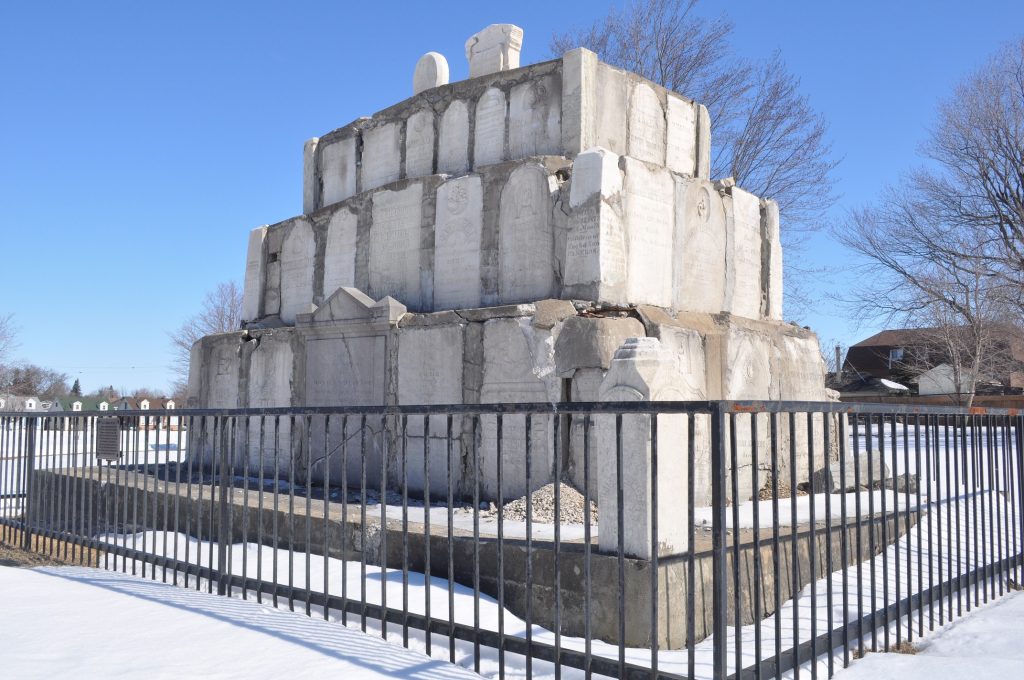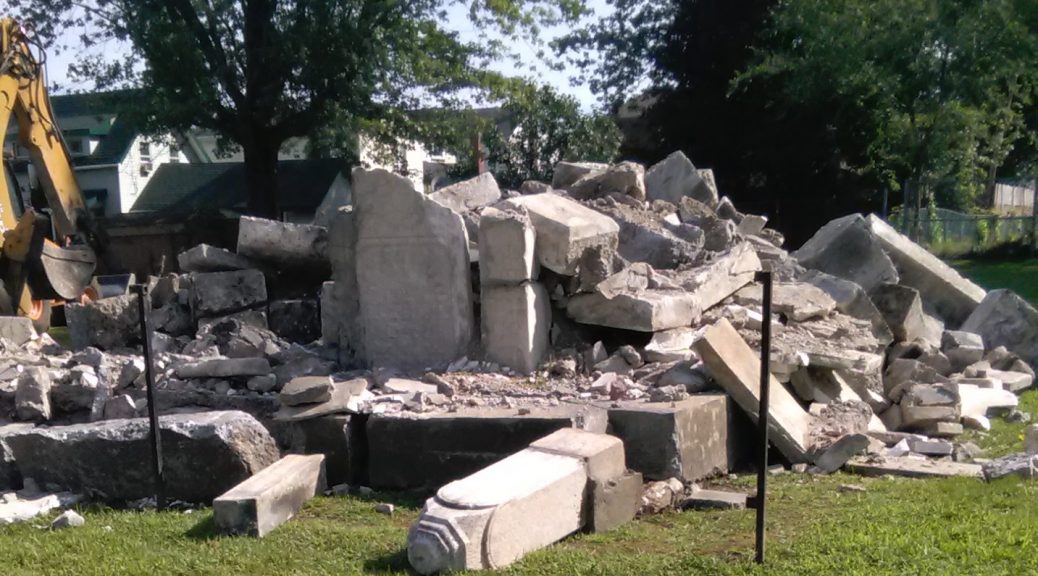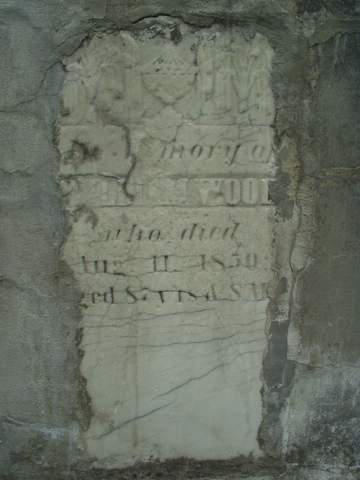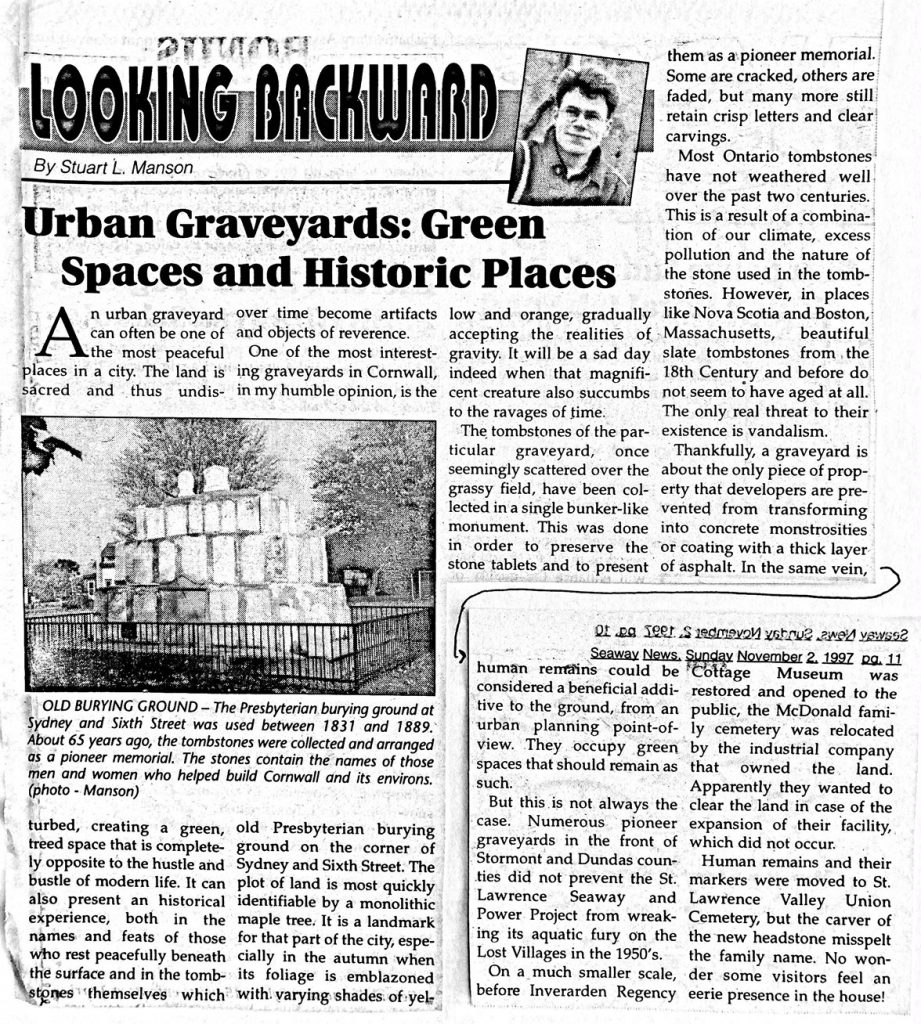Name: St. John’s Presbyterian Cemetery
Location: 88 Sixth St, Cornwall, ON
Confirmed Loyalist Burials:
- Neil McLean (Royal Highland Emigrants)
- William Wood (King’s Royal Regiment of New York)
Remarks:
This cemetery was established by the Presbyterian church in 1831, when the Church of England forbade Presbyterian burials in its graveyards. Its use as a burial site ended in 1889, when the Town of Cornwall passed a by-law outlawing burials with the municipality’s “Old Square Mile.” The church estimates that 600 people were buried here in that five-decade period. To this day, the property remains a legal cemetery.
For nearly a century, the cemetery looked like any other, with tombstones arranged in rows. By the late 1920s, however, the site was overgrown with vegetation, with obvious ill effects on the tombstones. In the words of the church, the owner of the property, “The cemetery lot fell into disuse and was not properly looked after.” The local newspaper reporter who observed the site stated it “grew wild with grass and shrubbery and did not present a very tidy appearance.”
Enter millionaire William R. Haggart, whose visit to his father’s final resting place induced him to donate money towards rehabilitating the cemetery. This prompted a subscription campaign where members of the church, descendants of those buried there, and other civic-minded citizens contributed financially to the effort. It resulted in a significant reorganization of the cemetery: The best-preserved tombstones, 67 in number, were arranged in a large cairn. The local newspaper, at the time of the 1932 unveiling, called this construction “a substantial and creditable memorial to departed relatives, one that will be preserved to posterity.”

A plaque erected in the 1980s, on a wrought iron fence surrounding the cairn, notes that it was a “memorial to the faith and labours of those who lie here.” In recent years, however, the monument began to show signs of age. Mortar holding the stones together had started to disintegrate. The community recognized that an important historical and cultural resource was in jeopardy, but no one could have anticipated what happened next.
On the morning on August 14, 2017, a wrecking crew hired by the church arrived on the site. They made quick work of the demolition of the cairn, with the assistance of a dump truck and two backhoes, one of which was fitted with a jackhammer. By afternoon nothing remained but a patch of topsoil surrounded by tire tracks. The photograph at the top of this page depicts the effects of this work, midway through the job.
There was no meaningful public notice of this demolition. While the Local Architectural Conservation Advisory Committee (a.k.a. Heritage Cornwall) was consulted, according to their meeting minutes the contemplated project was characterized as a “renovation.” The church later apologized, citing as its motivation the dangerous condition of the cairn (which was, in fact, surrounded by a wrought iron fence). They also offered the following baffling justifications for their action:
“A cemetery stone has no religious significance. It is strictly a marker locating or memorializing the burial of mortal remains.”
“Only a few of the names on the cairn relate to present day members of SJPC [St. John’s Presbyterian Church].”
The cemetery is particularly significant, from a Loyalist perspective, because it contains the remains of Neil McLean, who was the oldest surviving officer of the Royal Highland Emigrants (84th Regiment of Foot). McLean was also a heavyweight in the later military history of Canada and the local region: He was a captain in the Royal Canadian Volunteers (1796-1802) and a Lieutenant-Colonel of local militia, including flank companies, during the War of 1812. In 1890, his tombstone was said to be the oldest in the cemetery. This tombstone, unfortunately, did not survive the first period of neglect that prompted the building of the cairn in the 1930s.
Loyalist William Wood’s tombstone, pictured below, was part of the cairn, but it was destroyed in the 2017 demolition. (Only a couple tombstones were preserved, one only partially, we are told.) Wood was a soldier in the King’s Royal Regiment of New York. His former house is home to the Cornwall Community Museum, formerly the United Counties Museum in the Wood House.
For more information on this cemetery, please see the following:
- Stuart Manson, “A Legacy Lost: The Demolition of St. John’s Presbyterian Cemetery.” The Loyalist Gazette, Vol. LVI, No. 1 (Spring 2018), pp. 13-15.
- Sara Lauzon, “The Forgotten Souls at Sixth and Sydney.” The Senior Citizen, April 2017. CLICK HERE TO READ THE ARTICLE
- Stuart Manson, “Urban Graveyards: Green Spaces and Historic Places.” The Seaway News, November 2, 1997, p. 11. ARTICLE DEPICTED BELOW



